| Breakfast
With the Arts (with
Kelly Deadmon)
December 7, 2003 Transcribed by Kimberly Kelly Deadmon: Very little is known about the Dutch painter Johannes Vermeer. Only 35 of his paintings still exist. In a new film based on the novel by Tracy Chevalier, Colin Firth plays the artist. Here is a clip from The Girl With a Pearl Earring. [Camera obscura clip] For our viewers who havenít read the book, could you briefly tell us the story about The Girl With the Pearl Earring? Colin Firth: Itís set in Holland in the 17th century. I know it doesnít do a lot to sell a movie by itself, but itís about a girl from a poor family, who gets a job in the household of a famous painter and heís, um, heís somehow shrouded in mystery and enigma and she becomes fascinated with his work and gets drawn into his world. And he actually sees that and becomes fascinated with her and heís married with a large multitude of children, and this connection between them becomes more and more intense and, uh, itís obviously quite forbidden. Theyíre separated by an awful lot of things: class, age, culture and his marriage. And, you know, without wanting to give away too much about how it develops, thatís the setup. Kelly: What about the character appealed to you? Colin: (clears his throat) Um, I...well, thereís not much about this character that you can have to go on, apart from his work and the mystery surrounding him. And, in a way I think heís, heís created, heís written around that. (clears throat) Uh, we donít know much about him and rather than trying to invent a lot of characteristics for him, the mystery is preserved in the writing and I felt it was my job to, to preserve that in the performance as well. So, itís as much about concealing his emotions and his impressions as it is about revealing them. I think obviously what he goes through is extremely intense, otherwise he wouldnít produce the work that he does. But, um, I think that heís. . .itís not something he shares with people. I think that he actually was a man of great solitude. Heís alone in this world of. . .of light . . and, uh, vision until she comes into it. The fact that there wasnít so much known about him is quite liberating. Kelly: Right Colin: I mean, I didnít have to do any impressions, you know. I didnít have to put on a voice or, you know, I was very free in the physical performance in a way. Although, I did have a book to be faithful to. But what I did have to be careful of was not to do anything to blow how precisely heís judged in the original story here. Heís, you know . . .We mustnít, we mustnít know too much about him and we mustnít do anything to spoil the purity of the story. So everything had to be carefully judged. Thereís not a lot of dialogue between these people. And so little nuances can become very very important. And so that it was an exercise in precision as much as anything else. In some ways, that was, that was difficult, um, although I was free in that I didnít have to, you know, imitate JFK or, you know, Tony Blair. I was very carefully limited within the brief of the character because he, you know, he canít suddenly burst into song. [Kelly giggles] Kelly: I thought a lot of the scenes looked like a Vermeer painting. Colin: Yeah. Oh, yeah. I mean, when you see a Vermeer painting, it . . .Iím sure anybody whose job it is to light a room would cry out for the chance to, you know, to do that. And it was quite a magical moment, I have to say, to walk into the studio . . .to walk into the set when it was finally ready. And this was quite a suspenseful build up for me because we were filming for at least a month before that studio set was ready, you know. We were using corridors and the dining room and the kitchen and I didnít have a great deal to do for a while. In fact, I didnít have a great deal to do a lot of in the film, really. I was looking out of . . .Iíd come in, look out of a window, and then go home again. And, um, all the time thereís this build up about the studio and that was going to be the heart of the movie . . . and actually, the pressure was building up . . .so I thought: ďWhat if I get in there and nothing happens?Ē (clears throat) But the day I walked in when it was finished and dressedóhaving looked endlessly at these picturesówas pretty, you know, spine tingling. And then to see it lit was quite extraordinary, you know. He painted the same corner of that room over and over again in one form or another. He seems to have had some fixation with that spot. Itís almost as if he was trying to resolve something there or something, and the light coming in from the left to . . . and, uh, to actually stand in the room and see that happening, it was a thrill. Kelly: So, you didnít take up painting as a result? Colin: Oh, I tell you, I had to dabble at it. Yeah, I mean, Iíve tried it before. And, I spent a lot of time while filming, you know, with canvas and brush, experimenting with it. I even tried to paint that picture. Kelly: Howíd it go? Colin: Really, very, very badly [Kelly laughs] Colin: (smiling) It was quite an interesting exercise because I was being supervised by someone whose job it is to reproduce famous masterpieces. She knew exactly how to go about it, so she took me through the process and through every step, which I did disastrously. But, in doing it disastrously, it heightened my appreciation to what he had to have done masterfully. And, so it was. I mean the result was just hideous, but the exercise was quite valuable really. Kelly: So, thank you very much for talking with us today. I really appreciate it. Colin:
(shaking her hand) Thank you. Thanks.
|
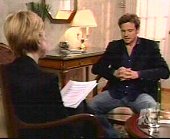

 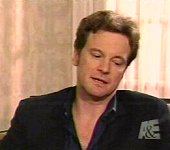
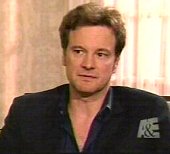

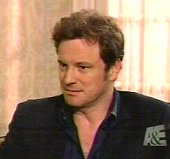
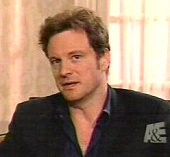
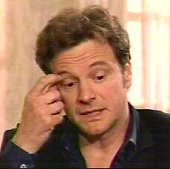

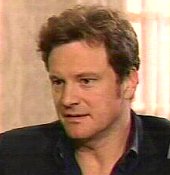
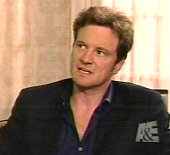
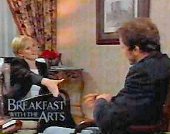 |